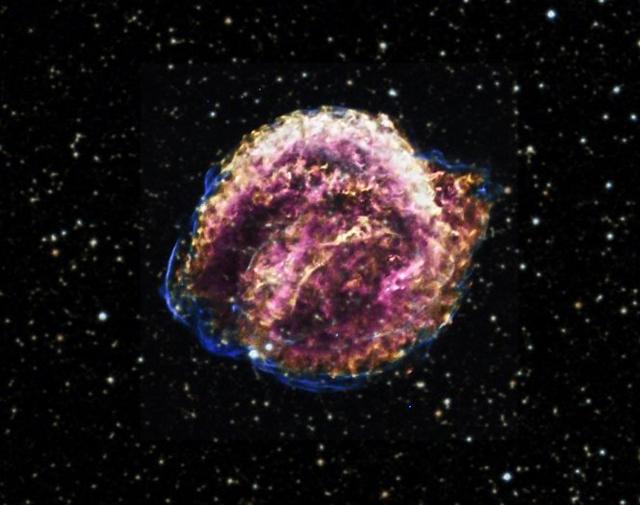Mary Burkey, a senior in physics, has been working on research with the physics department since high school and is now one of the few undergraduate students to be published in The Astrophysical Journal for her research on Kepler’s supernova.
A supernova is an explosion that occurs at the end of a star’s life cycle. The explosion occurs when a star becomes too massive to support itself. Stars fuse lighter elements in a process known as nuclear fusion to create energy that fuels the star itself. For example, a star may fuse hydrogen to produce helium, and then fuse that helium into even heavier elements, until most of the matter in the star becomes iron.
This iron, however, cannot go through fusion, because the energy required to do so is unsustainable. So the iron just sits there, building up in the core of the star and eventually leads to the star’s death. The star becomes incredibly dense, and, without any more energy to burn, collapses.
“Imagine a ball bouncing – you’ve got all this mass falling in from gravity. And then you’ve got a core that’s about as dense as you can get. And so what happens is that it will hit the core … and it can only get so dense, so it has to bounce back,” Burkey said.
This bounce back is the explosion that we call a supernova.
Scientists study the remnants of these exploded stars by observing the X-rays they emit.
Researchers at N.C. State, including Stephen Reynolds, a professor in the physics department, Kazik Borkowski, a research-associated professor in the physics department, and John Blondin, the department head of physics, have previously studied Kepler’s supernova. They published a paper based on information emitted from the Chandra X-ray Observatory, a satellite used to study stellar bodies.
Kepler’s supernova is classified as a type 1A supernova — a subset of supernova that came from exploding white dwarf stars. Kepler’s supernova was chosen to research because while scientists don’t completely understand type 1A supernovae as of yet, they do know that they behave slightly differently that the simplest type, called core collapse supernovae.
Borkowski, Reynolds and Blondin found that Kepler’s supernova was surrounded by matter called circumstellar medium. Circumstellar medium is mass that was shed by the star right before it exploded, and is often composed of oxygen, nitrogen and magnesium.
“It’s not supposed to be there – type 1A supernovae don’t have [circumstellar medium], at least according to the current model,” Burkey said.
Burkey, along with the aforementioned professors, worked with statistical models, studying the photon count of the mass around the supernova. Because different elements emit different wavelengths of light, she was able to determine what the circumstellar medium was composed of.
“I did several distinctive energy bands, and they corresponded to iron, magnesium, silicon and sulfur,” Burkey said.
She’s also discovered other unanticipated patterns – for example, there is a ring of the circumstellar medium, and a very isolated spot that contains almost twice the amount of iron.
The ring is significant because researchers can now look for particular ways the explosion would have occurred to produce that mass distribution.
“We’re pretty much trying to reverse engineer how this explosion went so that we can contribute to figuring out the model,” Burkey said.
The circumstellar medium containing iron was especially interesting to Burkey. The current accepted hypothesis about 1A supernovae is when they were stars, as they became more and more dense, they siphoned lighter elements off a nearby star, called a binary companion, using it for energy until both stars were depleted. This is called the binary star theory.
Unfortunately, researchers have yet to locate the hypothesized binary companion for Kepler’s star. They theorize that it could have been engulfed, depleted, or pushed away by the supernova. This iron mass could be evidence of its depleted core. On the other hand, it could also be the core of the original star that has simply shifted.
“That could be an interesting project, trying to figure out what that is,” Burkey said.
While this project didn’t change Kepler’s supernova’s classification, it did bring the scientific community closer to understanding what that classification means.
“Fundamentally [Kepler’s supernova] is still a type 1A … but the model is still under debate. We’re not sure if the binary star model is accurate, and so by studying this we can put together how it exploded and where the [circumstellar mass] came from,” Burkey said.








